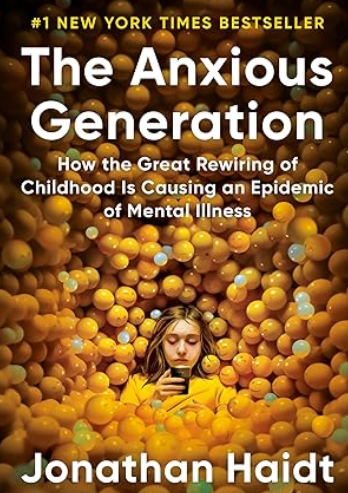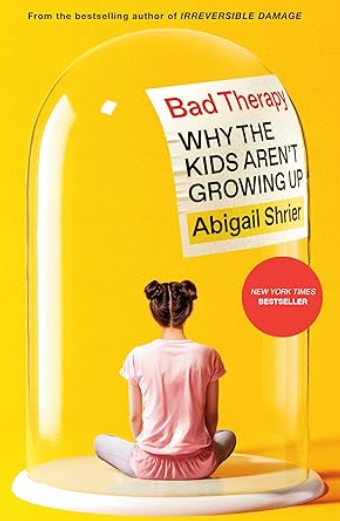Children of the Algorithm- Nick Cater
https://quadrant.org.au/magazine/2024/05/children-of-the-algorithm/
In 1952, the Radio Corporation of America revealed it was developing a portable receiver small enough to fit in a vest pocket. Glass vacuum tubes, the analogue precursor of the computer processor, would be replaced by a semiconductor smaller than a pea. By the end of the decade, the portable transistor radio was fast becoming ubiquitous among teenagers, fuelling rising moral panic about their character. “He has music wherever he goes,” reported the Australian Women’s Weekly in 1960. “It comes from the pocket-sized radio tuned to rock-’n-roll of the new and wildest sort.”
The impact of the transistor on my generation came to mind as I tried to pick holes in Jonathan Haidt’s compelling argument in The Anxious Generation: How the Great Rewiring of Childhood Is Causing an Epidemic of Mental Illness that the smartphone is the ruination of Generation Z, the cohort born between 1997 and 2022.
His thesis is that two recent trends—parental over-protection in the real world and under-protection online—have produced an anxious, demoralised, fragile and disconnected generation lacking the resilience required of adults. His conclusion, if rightly drawn, is more  than a little alarming for those of us who lie awake at night fretting about the future of humankind. The implication is that, sooner or later, the preservation of Western civilisation will be in the care of a damaged generation.
than a little alarming for those of us who lie awake at night fretting about the future of humankind. The implication is that, sooner or later, the preservation of Western civilisation will be in the care of a damaged generation.
I sought comfort from this disturbing reflection in the Beat generation whose sullenness, impertinence and lack of interest in the finer pleasures of music proved to be a passing phase. There were many social changes in the 1960s and 1970s that we now have cause to regret, but it would be wrong to pin the blame on technology nor yet proclaim that they were precursors of the end of civilisation. Haidt’s arguments are not so quickly shrugged off, however. It is hard to dismiss this distinguished thinker as just another moral-panic merchant when he brings solid data to the table.
Haidt traces a significant and sudden upturn in major depressive episodes beginning around 2012. The pattern is the same in every country where reliable data is collected. Major depressive episodes in the United States have increased by 145 per cent for girls and 161 per cent for boys. The incidence of anxiety and depression among college students was around 10 per cent in the early 2010s. Recent data shows depression now affects a fifth of US college students, and one quarter are afflicted by anxiety.
Degrees of anxiety correlate with age. The rate has decreased since 2012 by 8 per cent among the over fifties, but increased by 139 per cent for Americans aged between eighteen and twenty-five.
Haidt recognises that correlation is not causation and does the honourable thing by trying to destroy his own thesis. Could it be that more awareness of mental illness is leading to more frequent reporting? That seems unlikely when episodes of self-harm requiring hospital treatment are up by 188 per cent in girls and 48 per cent for boys. Suicide rates are up by 91 per cent for boys and 167 per cent for girls. Mental health hospitalisations for young Australian women aged twelve to twenty-four have increased by 81 per cent, and young men by 51 per cent.
Haidt takes stock of confounding variables, but concludes that none of them stack up. Unemployment over the relevant period trends in the opposite direction. Neither the Great Financial Crisis nor Covid can account for the trend. Everything points to the dismal conclusion that the rapid spread of social media since 2010 and smartphones since 2012 is responsible for what Haidt calls the great rewiring of childhood.
After slapping us into submission with statistics, Haidt draws from his specialist field, social psychology, for clinical evidence. He demonstrates that the proliferation of anxiety is just what we would expect when childhood goes online. Haidt makes the case that four foundational harms—social deprivation, sleep deprivation, attention fragmentation, and addiction—inevitably flow from spending a large slice of one’s developing years with half an eye on the smartphone. We have been conditioned to respond to alerts like …
Like what exactly? When social psychologists are reduced to rats and mice, they begin to lose their moral compass. Sure, when David Attenborough moves on to bonobos, it can occasionally feel as if we’re looking in a mirror, but just because we prefer mothers made of flesh and blood to those fabricated from wire and cloth doesn’t make us Harlow’s monkeys any more than salivating for beer when the sun goes down makes us Pavlov’s dogs.
We must resist the urge to respond to fatalism with fatalism or succumb to the feeling that we are flotsam and jetsam tossed around on a sea of troubles. Humans have agency. They are responsible for their own actions, ruling out the notion of technological determinism.
We have language which allows us describe problems and harness our collective skills to find solutions. We can find the will to resist harmful reflexes since we are blessed with what Robert Menzies called the greatest freedom of all: the freedom to do our best and make our best better.
Haidt, to be fair, leans more lightly than most psychologists on behavioural studies of our furry and feathered friends. Nonetheless, his book would have been easier to read if he hadn’t leant on them at all.
THIS IS WHY I found Abigail Shrier a more comforting companion on the journey to discover what’s messing with young people’s heads, despite Haidt’s many invaluable insights. Shrier builds on the ground covered in her last book, Irreversible Damage: The Transgender Craze Seducing Our Daughters (2020), which courageously forged into a world in which others fear to tread.
Shrier finds an explanation in the prevailing therapeutic culture and the influence of parents who have gone to extreme lengths to keep their children from harm, including the perceived damage inflicted by putting children in their place. They are reluctant to criticise poor behaviour or draw attention to a child’s mistakes. In doing so, they have robbed a generation of the capacity to act independently, to make their own choices irrespective of the social and cultural environment. They have been stripped of the ability to set goals, make decisions and take actions to shape the world around them.
Bad Therapy: Why the Kids Aren’t Growing Up draws upon similar data to Haidt to demonstrate the disturbing differences between Gen Z and its predecessors. Like Haidt, she notes the significance of the introduction of smartphones, an instrument that puts a child at greater risk when left alone in her bedroom than when left to her own devices in a playground.
Yet Shrier points the finger not at technology, but at the responsible adults who allowed and even encouraged Gen Z to take part in a dangerous experiment. First and foremost, she aims at the therapy industry by highlighting an obvious paradox: How does a generation that has received more psychological counselling than any in history turn out to be the loneliest, most anxious, depressed, helpless generation on record? How do adolescents growing up in unprecedented affluence with the enabling power of digital technology turn out to be so pessimistic, fearful and fatalistic?
Previous generations grew up with what psychologists called an internal locus of control, a  belief in one’s ability to improve one’s circumstances. The therapeutic culture Shrier attacks has encouraged an external locus of control which attributes events to external things, such as other people, climate change or bum luck.
belief in one’s ability to improve one’s circumstances. The therapeutic culture Shrier attacks has encouraged an external locus of control which attributes events to external things, such as other people, climate change or bum luck.
Haidt’s prophylactic recommendations to restrict teenage access to smartphones are sound. One of the first actions of Christopher Luxon’s conservative coalition in New Zealand was to ban them from schools. Any state government in Australia that does not take steps to enforce a similar ban here cannot be serious about reducing the prevalence of youth mental illness or reversing the decline in academic performance.
Yet age restrictions on smartphones are unlikely to be any more successful than age restrictions on smoking, particularly, as Haidt explains, social media designed to be addictive by the same evil Silicon Valley geniuses who think the age of consent for registering for an individual smartphone account is thirteen.
Which is why Shrier’s recommendations seem more helpful to me. She suggests we fight back against the vested interests in the therapy and pharmaceutical industries that stand to gain from the pathologisation of aberrant childhood behaviour. It’s time we offered resistance to those who try to insist that there is no such thing as a picky eater, just children who suffer from “avoidant restrictive food intake disorder”. We might work on helping kids improve their handwriting rather than make excuses for their “dysgraphia”. We might empower teachers to crack down on bad behaviour rather than excuse the perpetrators as the victims of “oppositional defiance disorder”, and encourage shy kids to come out of their shells rather than offering the debilitating diagnosis of “social anxiety disorder”.
In short, it is time to stand up to the tyranny of the experts, the wellness gurus and therapists responsible for the most unwell generation in recent history.
Yet Shrier does not spare Gen Z’s parents, whose lives are busier than ever. The mums are more likely to work than those of any previous generation, and smartphones have altered their behaviour, too. Adults, no less than children, respond to alerts and check their messages and social media posts. They are not opposed to interrupting family meals to take a phone call from the boss.
Like the delinquents in West Side Story, is Gen Z not entitled to defend itself against Officer Krupke’s allegations by claiming that it’s just their bringin’ upke that gets them out of hand?
Of course not, since avoiding personal responsibility is a symptom of the problem we’re trying to solve. Haidt points to abundant statistical and clinical evidence to show that the growth of attention deficit hyperactivity disorder is related in part to the rise of screen-based childhood.
The question Shrier raises is how those with primary responsibility for children’s welfare—their parents—might find a non-pharmaceutical solution by reviving some of the essential features of old-school parenting. Rather than imagining that the diagnosis exonerates them of responsibility, and seeking salvation through medication, might they not try harder to modify behaviour through chores, discipline and structure?
While by no means intending to diminish the gravity of Haidt’s conclusions, more attentive and conscientious parenting is surely worth a try. We rightly recognise our wartime ancestors as the greatest generation, but let’s not burden Gen Z with low expectations, sabotaging its chance to become the greatest generation of all.
The Anxious Generation: How the Great Rewiring of Childhood Is Causing an Epidemic of Mental Illness
by Jonathan Haidt
Penguin, 2024, 400 pages, $36.99
Bad Therapy: Why the Kids aren’t Growing Up
by Abigail Shrier
Sentinel, 2024, 320 pages, $32.99
Nick Cater is the author of The Lucky Culture (2013). He reviewed Arthur Calwell by James Franklin & Gerry O Nolan in the April issue.
Comments are closed.
